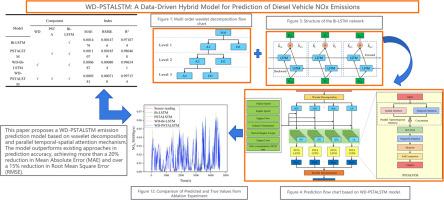WD-PSTALSTM: a data-driven hybrid model for prediction of diesel vehicle NOx emissions
IF 9.6
Q1 COMPUTER SCIENCE, ARTIFICIAL INTELLIGENCE
引用次数: 0
Abstract
Accurate prediction of transient nitrogen oxides (NOx) emissions from diesel vehicles is essential for precise emission inventories and effective pollution control but challenged by data nonlinearity and dynamic operating conditions. This study develops the Wavelet Decomposition (WD)-Parallel Spatiotemporal Attention-based Long Short-Term Memory (PSTALSTM) model, using real-world Portable Emission Measurement System (PEMS) and On-Board Diagnostics (OBD) data. WD preprocessing reduces emission data non-stationarity, generating more stable inputs. The PSTALSTM architecture, built upon Bidirectional Long Short-Term Memory (Bi-LSTM), incorporates a parallel attention mechanism to adaptively weight features and temporal segments, effectively capturing spatiotemporal correlations within the emission data. Validation with on-road test data demonstrates WD-PSTALSTM's superior performance over existing models. It achieves reductions exceeding 20 % in mean absolute error (MAE) and 15 % in root mean square error (RMSE), significantly enhancing prediction accuracy. These results establish WD-PSTALSTM as an effective approach for forecasting transient diesel engine NOx emissions. The research provides valuable methodologies for emission prediction based on vehicle operational data, contributing to environmental pollution mitigation efforts.

WD-PSTALSTM:用于预测柴油车氮氧化物排放的数据驱动混合模型
柴油车辆瞬态氮氧化物(NOx)排放的准确预测对于精确的排放清单和有效的污染控制至关重要,但数据非线性和动态运行条件对其提出了挑战。本研究利用真实世界的便携式发射测量系统(PEMS)和车载诊断(OBD)数据,开发了小波分解(WD)-基于并行时空注意力的长短期记忆(PSTALSTM)模型。WD预处理减少了排放数据的非平稳性,产生了更稳定的输入。PSTALSTM架构建立在双向长短期记忆(Bi-LSTM)的基础上,采用并行注意机制自适应加权特征和时间片段,有效捕获发射数据中的时空相关性。道路测试数据验证表明,WD-PSTALSTM的性能优于现有车型。平均绝对误差(MAE)降低20%以上,均方根误差(RMSE)降低15%以上,显著提高了预测精度。这些结果表明,WD-PSTALSTM是预测柴油机瞬态NOx排放的有效方法。该研究为基于车辆运行数据的排放预测提供了有价值的方法,有助于减轻环境污染。
本文章由计算机程序翻译,如有差异,请以英文原文为准。
求助全文
约1分钟内获得全文
求助全文
来源期刊

Energy and AI
Engineering-Engineering (miscellaneous)
CiteScore
16.50
自引率
0.00%
发文量
64
审稿时长
56 days
 求助内容:
求助内容: 应助结果提醒方式:
应助结果提醒方式:


